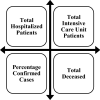Predictability of COVID-19-related morbidity and mortality based on model estimations to establish proactive protocols of countermeasures
- PMID: 34267295
- PMCID: PMC8282607
- DOI: 10.1038/s41598-021-93932-z
Predictability of COVID-19-related morbidity and mortality based on model estimations to establish proactive protocols of countermeasures
Abstract
The COVID-19 pandemic (SARS-CoV-2) has revealed the need for proactive protocols to react and act, imposing preventive and restrictive countermeasures on time in any society. The extent to which confirmed cases can predict the morbidity and mortality in a society remains an unresolved issue. The research objective is therefore to test a generic model's predictability through time, based on percentage of confirmed cases on hospitalized patients, ICU patients and deceased. This study reports the explanatory and predictive ability of COVID-19-related healthcare data, such as whether there is a spread of a contagious and virulent virus in a society, and if so, whether the morbidity and mortality can be estimated in advance in the population. The model estimations stress the implementation of a pandemic strategy containing a proactive protocol entailing what, when, where, who and how countermeasures should be in place when a virulent virus (e.g. SARS-CoV-1, SARS-CoV-2 and MERS) or pandemic strikes next time. Several lessons for the future can be learnt from the reported model estimations. One lesson is that COVID-19-related morbidity and mortality in a population is indeed predictable. Another lesson is to have a proactive protocol of countermeasures in place.
© 2021. The Author(s).
Conflict of interest statement
The authors declare no competing interests.
Figures
Similar articles
-
Comparison of hospitalized patients with COVID-19 who did and did not live in residential care facilities in Montréal: a retrospective case series.CMAJ Open. 2021 Jul 13;9(3):E718-E727. doi: 10.9778/cmajo.20200244. Print 2021 Jul-Sep. CMAJ Open. 2021. PMID: 34257090 Free PMC article.
-
COVID-19: a simple statistical model for predicting intensive care unit load in exponential phases of the disease.Sci Rep. 2021 Mar 3;11(1):5018. doi: 10.1038/s41598-021-83853-2. Sci Rep. 2021. PMID: 33658593 Free PMC article.
-
COVID-19 Trend Estimation in the Elderly Italian Region of Sardinia.Front Public Health. 2020 Apr 24;8:153. doi: 10.3389/fpubh.2020.00153. eCollection 2020. Front Public Health. 2020. PMID: 32391308 Free PMC article.
-
Characterization of SARS-CoV-2 different variants and related morbidity and mortality: a systematic review.Eur J Med Res. 2021 Jun 8;26(1):51. doi: 10.1186/s40001-021-00524-8. Eur J Med Res. 2021. PMID: 34103090 Free PMC article.
-
Deployment of an Interdisciplinary Predictive Analytics Task Force to Inform Hospital Operational Decision-Making During the COVID-19 Pandemic.Mayo Clin Proc. 2021 Mar;96(3):690-698. doi: 10.1016/j.mayocp.2020.12.019. Epub 2020 Dec 30. Mayo Clin Proc. 2021. PMID: 33673920 Free PMC article. Review.
References
-
- Raham, T. F. Epidemiological Philosophy of Pandemics (February 20, 2021). Available at SSRN: https://ssrn.com/abstract=3789738 or 10.2139/ssrn.3789738.
-
- Covid-19 High Attack Rate Can Lead to High Case Fatality Rate. Raham TF. medRxiv, 26 March 2021. 10.1101/2021.03.23.21254184 PPR: PPR303276.
-
- Agency of Public Health (2019). https://www.folkhalsomyndigheten.se/smittskydd-beredskap/utbrott/aktuell.... Accessed 3 Feb 2021.
-
- The National Board of Health and Welfare (2021). https://www.socialstyrelsen.se/en/about-us/. Assessed 2 March 2021.
-
- The Swedish Intensive Care Registry—SIR (2021). https://www.icuregswe.org/en/. Assessed 2 March 2021.
MeSH terms
LinkOut - more resources
Full Text Sources
Medical
Miscellaneous





